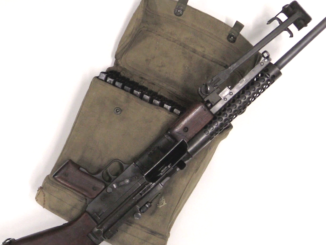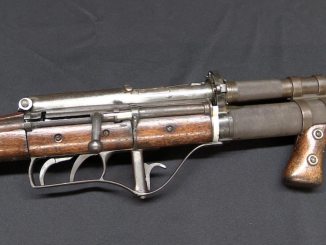With the Model of 1873, Winchester was able to address the major remaining weakness of the Henry and 1866 rifles – the cartridge. The 1873 was introduced in tandem with the .44Winchester Center Fire cartridge (known more commonly today as the .44-40). This cartridge kept the 200 grain bullet from the .44Henry Rimfire round, but used a brass case (as opposed to copper) and was able to increase the powder charge from 28 grains to 40, for a substantial increase in velocity.
In addition, the Model 1873 used a lighter steel frame and introduced a sliding dust cover on the top of the action to help keep out dirt and debris. The centerfire nature of the cartridge made it possible to handled ammunition when a commercial source was not available (Winchester sold the reloading tools). The 1873 was available with a wide variety of options, including barrel and magazine lengths, buttstock and grips, sights, and fancy options like engraving. It would prove to be a massively popular weapon both in the United States and abroad, cementing Winchester’s position as the premier manufacturer of American repeating rifles.




“centerfire nature of the cartridge made it possible to handled ammunition when a commercial source was not available”
Should not be handload instead of handled?
You nitpick…. 🙂
But of course, you are right.
I seem to remember that years ago when a popular magazine such as the .American Rifleman, Gun .World, Guns and Ammo would do a story featuring a specific firearm, there would be an increased interest in that firearm, with an accompanying increase in prices.
Has it been observed that this phenomenon is “shown up” with your videos?
I wonder if the prices of original Henry’s (which are quite high already) and now the remainder of the Winchester lever family will see an increase in the value at auction.
My thought in past was always: how well would .44 caliber bullet fly say at 200 yards. Probably ok, but at twice the distance, as often showcased in movies – maybe not as much.
Therefore, the .38 makes quite a bit of sense, especially given the increased powder charge. Again, good show – and I appreciate.
“.38 makes quite a bit of sense”
Does .38 stands for .38-40 Winchester Center Fire? If yes: then .38 is not truly .38, as .44 is not .44, using true bullet diameter it would be .401 and .427 so difference is smaller than it might look.
Really?! So again, those inch values are so deceiving… oh well. We talked enough about it in previous.
“values are so deceiving”
To make situation even less clear there was time when Winchester manufactured both “fake” .38 i.e. 38-40 and “true” .38 i.e. 38-55 Winchester: https://en.wikipedia.org/wiki/.38-55_Winchester
Reading from Chuck Hawks page; he does not seem to be too enthusiastic in its description:
http://www.chuckhawks.com/38-40win.htm
(… underpowered, hard to reload…)
This will lead me to even more scepticism over westerns. But I do not watch them anymore anyway.
The widely quoted muzzle velocities¹ for the .38-40 do not really make sense, and it appears that they were measured with a relatively modern smokeless powder load, probably deliberately weak in order to make it as safe as possible if fired from an old black powder era firearm.
In fact, very simple physics tells us that if loaded with original 40 grains of black powder, .38-40 should have a higher muzzle velocity than .44-40, because the former fires a lighter projectile. There is no way the muzzle velocity could have been lower as Chuck Hawks and others suggest.
¹ Only 1,160 fps from a 24″ barrel (180 grain projectile).
“do not really make sense”
Data obtained by Taffin, can be found here:
http://www.sixguns.com/tests/tt3840.htm
these date are for modern revolver (Ruger Blackhawk Convertible) and can NOT be excepted from older weapons. He also gives velocity of black-powder original, from revolver: 180 gr @ 975 fps. This cartridge is described as harder to reload than modern (straight-wall) revolver cartridges. Taffin summary is that:
It is very difficult to justify the existence of the .38-40 anymore. It is not a silhouette pistol. Factory ammunition is expensive and under-powered.
“Only 1,160 fps from a 24″ barrel (180 grain projectile)”
Here: https://www.starlinebrass.com/articles/The-38-WCF-38-40/
muzzle velocity for black-powder original is 180 gr @ ~ 1300 fps @ 24″ barrel (and 900 fps @ 7.5″ barrel)
Truth is the 38 WCF is the ballistic twin of the 40 Smith & Wesson
Well there is some confusion on the 38 WCF. Why Winchester call it a 38 whereas the bullet was a .401 caliber? Marketing Reasons? Who knows?
The original loading was 38 gr black powder behind a 180 gr .40 caliber bullet, so it should have been called the 40-38.
That’s became funny when Winchester started manufacturing a specific variant for the Colt Lightning pump rifle with a 40 gr load that was headstamped 38-40.
So from Winchester point of view, the 38 WCF was for their rifles (and Colt revolvers) and the 38-40 was for Colt rifles!
Why this cartridge was created in the first place is also an interesting question. The external ballistics seem to have been very similar to the .44-40. The bullet of the .38-40 has a slightly higher sectional density, but not enough to really make much difference, and the muzzle velocity was similar as well. On the other hand, the bullet is not much lighter, which means that the recoil impulse is only slightly lower and in any case recoil would not have been a major consideration for a rifle cartridge.
The only raison d’être I can think for the .38-40 is small and medium game hunting, where a smaller diameter bullet would be preferable. Even that begs the question, though, why then .401 and not .38 or even .32 caliber?
“why then .401 and not .38 or even .32″
I think, it is possible that Winchester at that time has equipment has equipment for making .401” barrels and so they choose it, though I am not enough knowledge to point Winchester cartridge with 100% sure.
.40-60-210 Winchester seems to be possible:
http://www.municion.org/Win/40-60Win.htm
introduced in 1876.
If article at starlinebrass which I linked earlier, is true in
It has been written that the .38 WCF was introduced by Winchester in 1874 as the second chambering of their Model 1873. That is incorrect. It most certainly was the second chambering offered for that lever gun but the year of introduction was 1879.
Then it make sense, to say that choice of .40 caliber was due to usage of existing equipment.
“why then .401 and not .38 or even .32”
Also, they might want to retain some rim diameter as in .44-40, which if you want to use .32 would give heavy bottle-neck, which might be harder (more expenisve) to produce that moderately bottle-necked .38-40.
Eric at IV8888 got reasonable accuracy, but an arcing trajectory. https://www.youtube.com/watch?v=fhSOoVBPv08
Just as one would expect if one has at least basic understanding of external ballistics. Not that it isn’t interesting to see someone actually do it in practice.
Eventually, justice for Mr. Henry is done.
Even in metric, loading on Sunday is good.;)
It’s been a long time since I’ve gotten a look at all 3 versions of the Winchester 1873, but I have to say that the musket version really should have received a knife bayonet and a proper bayonet lug rather than the impractical pig-sticker similar to ones that all conventional army brass seemed to force upon “the uneducated masses” of soldiers…
Good point about black powder fouling management. In fact very few crud gets its way to the toggle compartment of the action. Even with well expanded brass, a 92 get a lot of fouling in the action. A 73 action only needs a little swipe of the bolt head, the elevator and the elevator well.
How much did factory .44-40 cost in 1873? I wonder how much target practice the average Winchester 1873 (or Colt SAA for that matter) owner could have afforded> Could a cowboy have afforded ammo to practice? How much did the military practice?
My gut feeling is that the idea that the olden days were filled with sharpshooters is wrong. Some soldiers, the rich and professional hunters may have had enough ammo to get good but for the majority the gun was a seldom used tool.
Ian and Karl addressed this question in their May Q&A video:
https://www.full30.com/video/77314fd81a50812b9a01de5ae0934acd
To summarize, ammunition during the “Wild West” era was more expensive than today but not so expensive that marksmanship training would have been impossible if you really wanted to do it. Reloading was very common as well. Since the bullets were simple lead castings, you didn’t even have to buy ready-made bullets if you wanted to save money or they were not available.
The question of nose-to-primer storage in tube magazines isn’t mentioned. How is the problem addressed for .44-40? Flat nosed bullets seem like at least a partial fix. But I recall a video demonstrating how cartridge taper, plus a groove around the primer for spitzer tips, were supposed to keel Lebels from chain detonation.